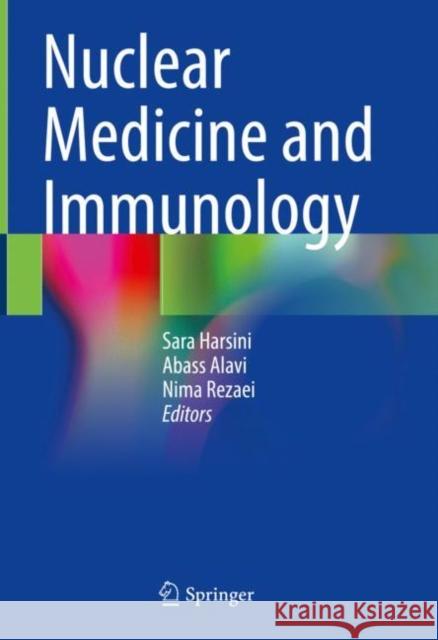Nuclear Medicine and Immunology » książka



Nuclear Medicine and Immunology
ISBN-13: 9783030812607 / Angielski / Twarda / 2021 / 553 str.
Nuclear Medicine and Immunology
ISBN-13: 9783030812607 / Angielski / Twarda / 2021 / 553 str.
(netto: 512,85 VAT: 5%)
Najniższa cena z 30 dni: 535,99 zł
ok. 20 dni roboczych.
Darmowa dostawa!
1. Molecular Imaging in Inflammatory and Autoimmune Disorders.- 2. Gallium Imaging of Infection and Inflammation.- 3. 111Indium-Labeled Leukocyte Imaging of Infection and Inflammation.- 4. 99mTc-HMPAO-Labeled-Leukocyte Imaging of Infection and Inflammation.- 5. FDG-PET Imaging of Infection and Inflammation.- 6. Imaging Procedures with Radiolabeled Monoclonal Antibodies.- 7. Dosimetric Principles of Targeted Radiotherapy.- 8. Radioimmunotherapy (RIT).- 9. Peptide Receptor Radionuclide Therapy (PRRT).- 10. Tumor Architecture and Targeted Delivery.- 11. Antibodies and Novel Constructs for Tumor Targeting.- 12. Pretargeted Radioimmunotherapy of Cancer.- 13. Radioimmunotherapy of Lymphoma.- 14. Radioimmunotherapy in Brain Tumors.- 15. Radioimmunotherapy of Pancreatic Adenocarcinoma.- 16. Radioimmunotherapy of Renal Cell Carcinoma.- 17. Radioimmunotherapy of Prostate Carcinoma.- 18. Radioimmunotherapy of Ovarian Cancer.- 19. Targeted Radiotherapy in the Treatment of Osteosarcoma.- 20. Targeted Radiotherapy of Neuroblastoma.- 21. Targeted Radiotherapy of Squamous Cell Carcinoma of the Head and Neck.- 22. Moving Forward: Expected Opportunities for the Development of New Therapeutic Agents.- 23. Translation of Radiopharmaceuticals from Bench to Bedside.
Sara Harsini is an Iranian board-certified Nuclear Medicine and Molecular Imaging physician graduated from Tehran University of Medical Sciences. Her research focuses on molecular imaging, molecular oncology, positron emission tomography and immunology. She has won several national and international awards in both educational and research fields, is a member of various scientific organizations and has authored numerous journal publications.
Abass Alavi is an Iranian-American physician-scientist specializing in the field of molecular imaging, most notably the imaging modality of positron emission tomography (PET). In August 1976, he became the first to perform human PET studies of the brain and whole body using the radiotracer [18F]Fluorodeoxyglucose (FDG). Alavi is a Professor of Radiology and Neurology, as well as Director of Research Education at the University of Pennsylvania’s Department of Radiology. He has authored over 2,900 publications and won numerous awards and distinctions, including the highest distinctions in nuclear medicine: the Society of Nuclear Medicine’s Georg Charles de Hevesy Nuclear Pioneer Award and Cassen Prize, and honorary degrees from the University of Bologna, the University of the Sciences in Philadelphia and Shiraz University in Iran. He also received the de Hevesy Award from the Society of Nuclear Medicine for his pioneering work in the development of positron emission tomography. He is an internationally respected expert on modern imaging techniques and clinical applications of PET imaging for the detection of cancer, as well as on neurological, cardiovascular, and infectious disorders.
Nima Rezaei, an Iranian scientist, is a Professor of Clinical Immunology at Children's Medical Center, and Vice Dean of International Affairs in the School of Medicine, Tehran University of Medical Sciences. He is the mastermind behind and founder and current President of the Universal Scientific Education and Research Network (USERN). Rezaei is known for his research in primary immunodeficiencies, characterization and treatment. He has authored more than 750 publications, and has received several awards in his research and scientific areas as well as educational work.
This book explores the close connection between immunology and nuclear medicine, which has led to radioimmunoimaging and radioimmunotherapy (RIT).
Molecular imaging with positron emission tomography (PET) and single-photon emission computed tomography (SPECT) is increasingly being used to diagnose, characterize, and monitor disease activity in the context of inflammatory disorders of known and unknown etiology, such as sarcoidosis, atherosclerosis, vasculitis, inflammatory bowel disease, rheumatoid arthritis, and degenerative joint disease. The first chapters discuss the various radiopharmaceutical agents and radiolabeled preparations that have been employed in inflammation imaging. Of these, FDG-PET imaging has been shown to have the great value in the detection of inflammation and has become the centerpiece of several initiatives over the last several years. This very powerful technique will play an increasingly important role in the management of patients with inflammatory conditions in the future.
The book also explores the growing role of nuclear medicine and molecular imaging in the diagnosis and treatment of cancer. The rapid pace of change has been fueled by advances in our understanding of tumor biology, on the one hand, and the development of specifically targeted medical therapies, diagnostic agents, and radiotherapies, on the other.
Written by leading international experts in the field, this book is an invaluable tool for nuclear medicine physicians, radiologists, oncologists, and immunologists.
1997-2025 DolnySlask.com Agencja Internetowa
KrainaKsiazek.PL - Księgarnia Internetowa









